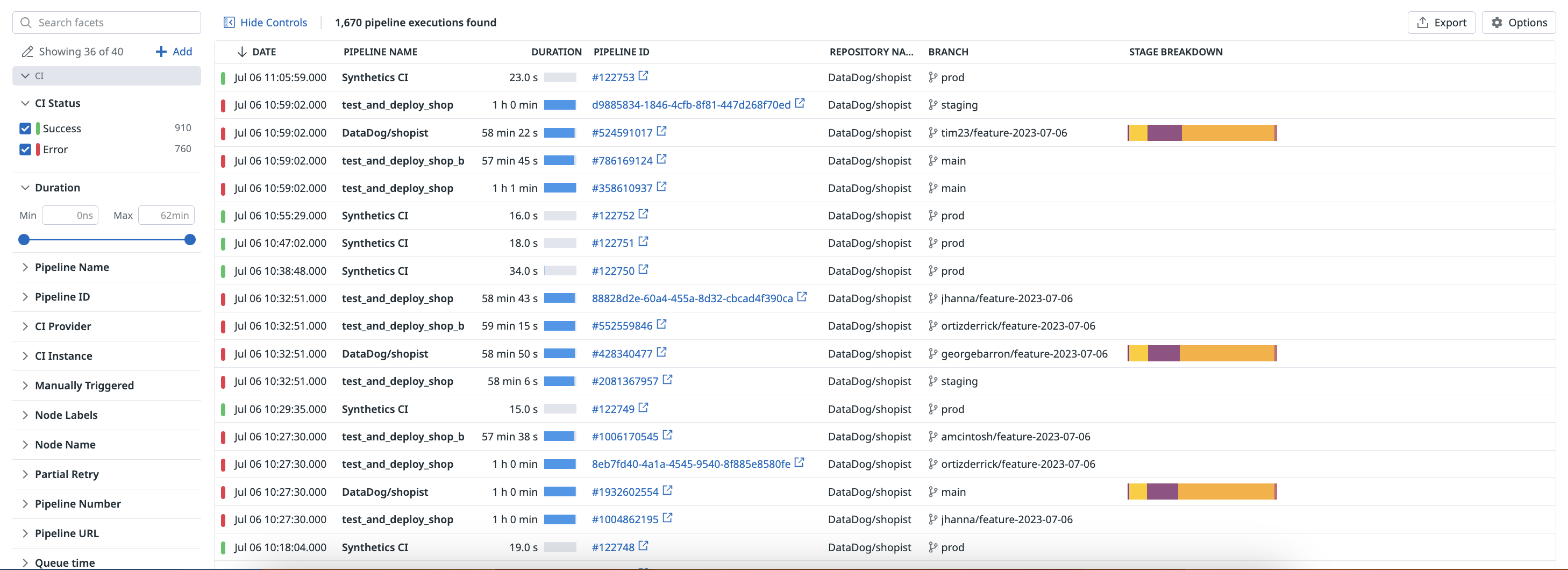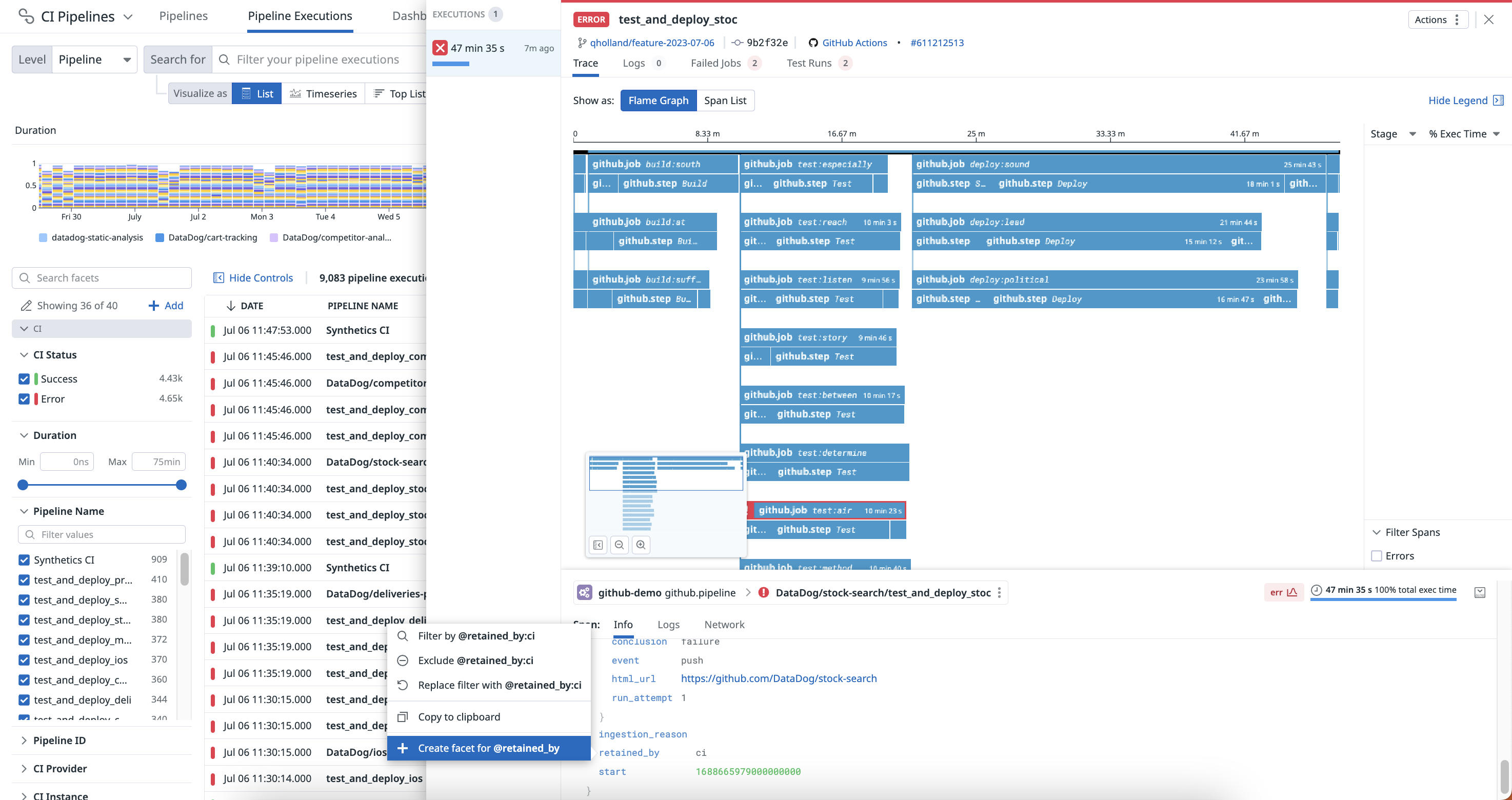- Essentials
- Getting Started
- Agent
- API
- APM Tracing
- Containers
- Dashboards
- Database Monitoring
- Datadog
- Datadog Site
- DevSecOps
- Incident Management
- Integrations
- Internal Developer Portal
- Logs
- Monitors
- OpenTelemetry
- Profiler
- Session Replay
- Security
- Serverless for AWS Lambda
- Software Delivery
- Synthetic Monitoring and Testing
- Tags
- Workflow Automation
- Learning Center
- Support
- Glossary
- Standard Attributes
- Guides
- Agent
- Integrations
- Developers
- Authorization
- DogStatsD
- Custom Checks
- Integrations
- Create an Agent-based Integration
- Create an API Integration
- Create a Log Pipeline
- Integration Assets Reference
- Build a Marketplace Offering
- Create a Tile
- Create an Integration Dashboard
- Create a Monitor Template
- Create a Cloud SIEM Detection Rule
- OAuth for Integrations
- Install Agent Integration Developer Tool
- Service Checks
- IDE Plugins
- Community
- Guides
- OpenTelemetry
- Administrator's Guide
- API
- Partners
- Datadog Mobile App
- DDSQL Reference
- CoScreen
- CoTerm
- Cloudcraft (Standalone)
- In The App
- Dashboards
- Notebooks
- DDSQL Editor
- Reference Tables
- Sheets
- Monitors and Alerting
- Metrics
- Watchdog
- Bits AI
- Internal Developer Portal
- Error Tracking
- Change Tracking
- Service Management
- Actions & Remediations
- Infrastructure
- Cloudcraft
- Resource Catalog
- Universal Service Monitoring
- Hosts
- Containers
- Processes
- Serverless
- Network Monitoring
- Cloud Cost
- Application Performance
- APM
- APM Terms and Concepts
- Application Instrumentation
- APM Metrics Collection
- Trace Pipeline Configuration
- Correlate Traces with Other Telemetry
- Trace Explorer
- Recommendations
- Code Origins for Spans
- Service Observability
- Endpoint Observability
- Dynamic Instrumentation
- Live Debugger
- Error Tracking
- Data Security
- Guides
- Troubleshooting
- Continuous Profiler
- Database Monitoring
- Agent Integration Overhead
- Setup Architectures
- Setting Up Postgres
- Setting Up MySQL
- Setting Up SQL Server
- Setting Up Oracle
- Setting Up Amazon DocumentDB
- Setting Up MongoDB
- Connecting DBM and Traces
- Data Collected
- Exploring Database Hosts
- Exploring Query Metrics
- Exploring Query Samples
- Exploring Database Schemas
- Exploring Recommendations
- Troubleshooting
- Guides
- Data Streams Monitoring
- Data Jobs Monitoring
- Data Observability
- Digital Experience
- Real User Monitoring
- Synthetic Testing and Monitoring
- Continuous Testing
- Product Analytics
- Software Delivery
- CI Visibility
- CD Visibility
- Deployment Gates
- Test Optimization
- Quality Gates
- DORA Metrics
- Security
- Security Overview
- Cloud SIEM
- Code Security
- Cloud Security
- App and API Protection
- Workload Protection
- Sensitive Data Scanner
- AI Observability
- Log Management
- Observability Pipelines
- Log Management
- Administration
Pipeline Execution Facets
This product is not supported for your selected Datadog site. ().
Overview
Facets are user-defined tags and attributes from your pipelines. They are useful for both qualitative and quantitative data analysis. Facets allow you to manipulate your pipelines in your CI Pipeline monitors, and in search queries that appear on dashboards and in notebooks.
Creating facets is not required for searching pipeline executions. Autocomplete capabilities use existing facets, but also any input that matches incoming pipeline executions applies.
Common facets
Navigate to Software Delivery > CI Visibility > Executions to access the list of facets left of the pipeline executions list.
The CI Visibility Explorer includes the following out-of-the-box facets:
| Facet | Description |
|---|---|
| CI Provider | Name of the CI provider (GitHub, GitLab, and more). |
| Pipeline Name | Name of the CI pipeline. |
| Node Name | Name of the CI node that executed the pipeline, stage, or job. |
| Node Labels | Labels associated with the CI node that executed the pipeline, stage, or job. |
| Pipeline URL | Provider URL for a pipeline execution. |
| Pipeline ID | ID of the pipeline. |
| Pipeline Number | Execution number of a CI pipeline, provided by the CI Provider. This increases when partially retrying a pipeline. |
| Job URL | Provider URL for a job execution. |
| Stage Name | Name of the CI stage. |
| Job Name | Name of the CI job. |
| Kubernetes Namespace | The namespace in which the Kubernetes Pod is running. |
| Kubernetes Pod Name | Name of the Kubernetes Pod. |
| Image Tag | Kubernetes Container image tag. |
| Container Name | Kubernetes Container name tag. |
| Image Name | Kubernetes Container image name tag. |
| Container ID | Kubernetes Container ID. |
| Kubernetes Container Name | Name of the Kubernetes Container. |
| Kubernetes Deployment | The Kubernetes Deployment a pod belongs to. |
| Kubernetes Stateful Set | The Kubernetes StatefulSet a pod belongs to. |
| Repository URL | URL of the Git repository. |
| Repository ID | ID that uniquely identifies a Git repository. |
| Commit SHA | Git Commit SHA. |
| Branch | Git Branch. |
| Tag | Git Tag. |
| Author Email | Git Author Email. |
| Committer Email | Git Committer Email. |
| Committer Date | Git Committer Date. |
| Author Date | Git Author Date. |
| Env | The environment in which the CI pipeline is running. |
| Resource | The resource utilized by the CI pipeline. |
| Operation Name | The operation performed within the CI pipeline. |
| Error Type | Type of error encountered during the CI execution. |
| Type | Type of the CI execution or entity. |
| Complete Trace | Full trace of the CI pipeline execution. |
| Duration | The duration of the execution in seconds. |
| Version | Version of the CI pipeline or tool used. |
| Is Default Branch | Indicates if the execution was run on the default branch of the Git repository. |
You can use facets in the CI Visibility Explorer to:
- Search for and filter pipeline executions
- Perform pipeline analytics
- Start troubleshooting once your pipelines complete
Qualitative facets
Use qualitative facets when you need to:
- Get relative insights for values.
- Count unique values.
- Frequently filter your pipeline executions against particular values. For example, create a facet on an environment tag to scope troubleshooting down to development, staging, or production environments.
Note: Although facets are not required for filtering on tags, defining facets for tags that you often use during investigations can help reduce your time to resolution.
Quantitative measures
Use quantitative measures when you need to:
- Aggregate values from multiple pipeline executions.
- Range filter your pipeline executions.
- Sort your pipeline executions against that value.
Types
Measures have either a long integer or double value for equivalent capabilities.
Units
Measures support units (time in seconds or size in bytes) for handling of orders of magnitude at query time and display time. The unit is a property of the measure itself, not of the field.
For example, consider a duration measure in nanoseconds. Suppose pipeline executions from service:A have duration:10000000, meaning 10 milliseconds. Supposed pipeline executions from service:B have duration:5000000, meaning 5 milliseconds. Use duration:>2ms to consistently query pipeline execution tags from both services at once. For more information about search queries, see Search Syntax.
Facet panel
The search bar provides the most comprehensive set of interactions to filter and group your data. However, for many cases, the facet panel is a straightforward way to navigate into your data. Open a facet to see a summary of its content for the scope of the current query.
The search bar and URL automatically reflect your selections from the facet panel.
- Facets (qualitative) come with a top list of unique values, and a count of pipeline executions matching each of them.
- Measures (quantitative) come with a slider indicating minimum and maximum values. Use the slider, or input numerical values, to scope the search query to different bounds.
Grouping facets
Facets are grouped into meaningful themes in the facet list. Assigning or reassigning a group for a facet affects only the facet list, and has no impact on search or analytics.
Filtering facets
Use the search facets box on the facet panel to scope the whole facet list and navigate to the facet you need to interact with. Search facets uses the facet display name and field name to scope results.
Creating facets
Creating a facet on a pipeline execution attribute or tag is not a mandatory step to search for pipeline executions. Facets are useful if you wish to add a meaningful description to a specific pipeline execution attribute, or if you want the attribute values to appear on the Facets list.
Creating facets from the Pipeline Executions side panels
The easiest way to create a facet is to add it from the Pipeline Executions side panel so that most of the facet details are pre-filled.
Navigate to a pipeline execution of interest in the CI Visibility Explorer that contains the field to create a facet on.
Open the Pipeline Executions side panel by selecting the pipeline execution from the list.
Click on the desired field (in the Info tab for a pipeline execution’s span) and create a facet from there:
- If the field has a numerical value, you can create either a facet or a measure.
- If the field has a string value, only facet creation is available.
Creating facets from the facet list
If finding a pipeline execution that has the desired field is not an option, create a facet directly from the facet panel by clicking + Add.
Define the underlying field (key) name for this facet:
- Use tag key name for infrastructure tags.
- Use the attribute path for pipeline execution attributes, with
@prefix.
Autocomplete based on the content in pipeline executions of the current views helps you to define the proper field name. But you can use virtually any value here, specifically in the case that you don’t yet have matching pipeline executions received by Datadog.
Further reading
Additional helpful documentation, links, and articles:



